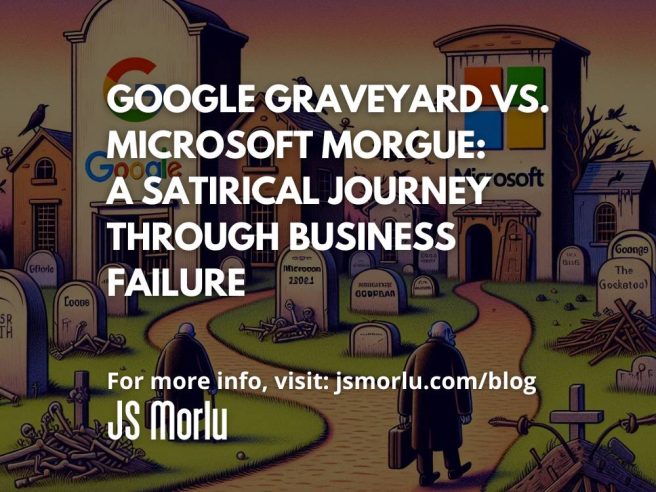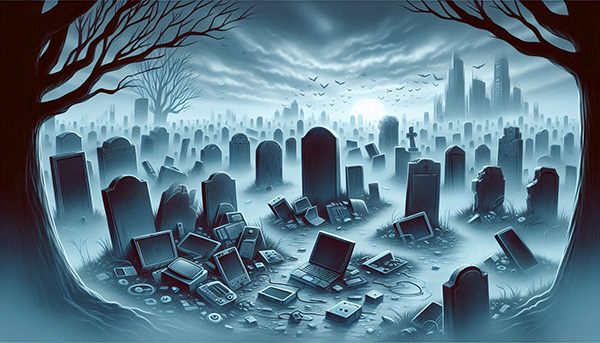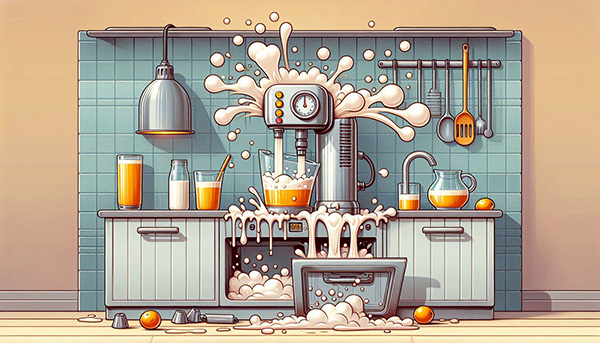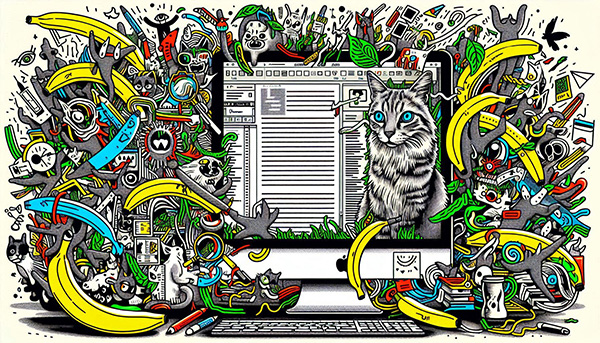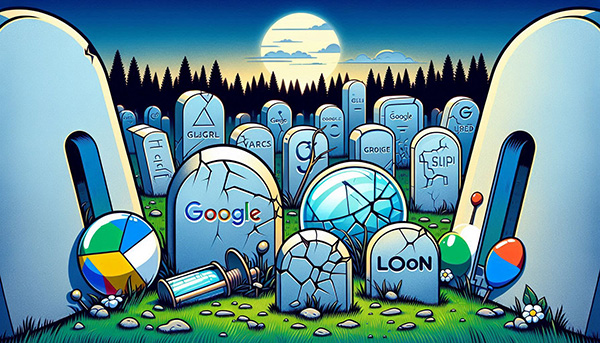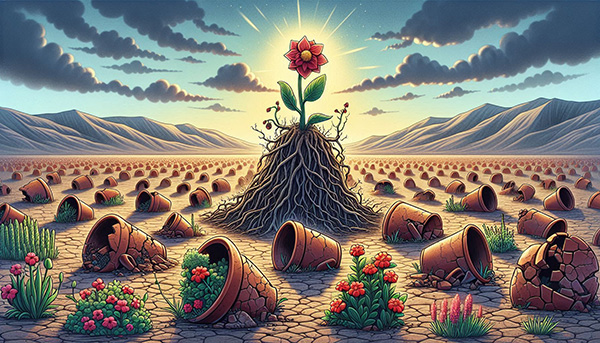By: John S. Morlu II, CPA
Introduction
In the fast-paced world of business, where the next big idea is always just around the corner, failure is not only an option—it’s a well-trodden path. While we celebrate the dazzling successes of companies like Apple, Tesla, and Google, for every unicorn that rockets to a billion-dollar valuation, there’s a parade of ideas that stumble out of the gate and collapse in a heap of unmet potential. It’s easy to romanticize the startup world with its promise of innovation and disruption, but the truth is, the business landscape is littered with the wreckage of ideas that never quite made it out of the conceptual phase. Even at institutions as prestigious as MIT, where some of the world’s brightest minds develop cutting-edge technologies, less than 6% of patents ever reach the commercial stage. That includes patents licensed to companies who seemingly have all the tools for success but still find themselves lost in the labyrinth of execution.
Welcome to the whimsical yet cautionary tale of corporate misadventures, where ambitious startups and entrepreneurial dreams take their place alongside once-mighty corporate giants—in a far less glamorous graveyard. In this eerie business afterlife, once-hopeful ventures such as mood-based wine apps and pet mindfulness regimes spend eternity in the shadow of their own ambition. Picture this: a realm where the spirits of overzealous ideas hover like cautionary ghosts, each one whispering lessons from the past. Listen closely, and you might hear the wistful echoes of VibeVino, the app that thought it could cure your heartbreak with a bottle of Merlot, or the haunted hum of PetZen’s yoga classes for dogs—a sound as perplexing as it was ill-conceived.
These aren’t just stories of failure—they’re tales of what happens when boundless enthusiasm meets the unyielding wall of consumer reality. For every brilliant idea that changed the world, there are countless others that crashed and burned, teaching us that innovation is not always synonymous with success. Sometimes, the most visionary product is no match for the whims of the market, consumer behavior, or the simple fact that some problems don’t need solving.
As we embark on this journey through the “Google Graveyard” and the “Microsoft Morgue,” prepare to uncover the absurd, the amusing, and the downright perplexing stories of businesses that aimed for the stars but crash-landed in a heap of shattered dreams and uncarbonated fizz. There’s humor to be found in their demise, not out of malice but because the pursuit of success can sometimes be as comical as it is inspiring. After all, who wouldn’t chuckle at the thought of FizzFrap, a home carbonation machine that turned everything—milk, orange juice, and even coffee—into an undrinkable fizzy mess? Or the fate of InstaPie, an app that thought it could turn anyone into a pizza chef but ended up delivering nothing but half-baked ideas?
So, grab your metaphorical shovel and join us as we dig up the stories of these fallen ventures. We’ll explore the graves of ideas that were buried far too soon, uncovering the delightful absurdities and hard-earned lessons that lie beneath. Because in the end, if you can’t laugh at failure, you may never see the wisdom it leaves behind. And who knows? By understanding what didn’t work, you might just find the keys to what will.
Chapter 1: The Funeral Procession Begins
Failure in business is as inevitable as your office printer jamming when you’re running late for a meeting—it’s just a matter of time. Whether it’s a scrappy startup fueled by endless enthusiasm and ramen noodles or a corporate titan with a war chest of cash, everyone stumbles eventually. And when they do, they inevitably find themselves in one of two places: the Google Graveyard or the Microsoft Morgue—the ultimate resting grounds for tech products and business ideas that were probably better left as drunken brainstorms scribbled on a bar napkin.
These tech cemeteries aren’t exclusive to the titans of industry, either. Sure, they may house the headstones of once-ambitious juggernauts like Google Glass, Microsoft Zune, and Yahoo Screen, but nestled in between the larger-than-life failures are the tombstones of smaller, scrappier businesses. Companies that started with a dream, a logo, and maybe a mascot, but ultimately left behind only one final message etched into stone: “Oops, maybe we should’ve done more market research,” or the classic, “Turns out, nobody wanted this after all.”
Before we dive too deep into the eulogies of InstaPie and WordPal, let’s take a moment to appreciate the vastness of the tech graveyard. It’s an eclectic assortment of the ridiculous and the almost revolutionary. This is a place where ambition often outpaced wisdom, where half-baked ideas collided with the hard truth of user indifference, and where optimism was left standing at the altar by consumer reality.
As the procession winds through this fog-laden field of broken dreams, it’s hard not to notice a few infamous names resting in eternal peace. There’s Google Glass, that awkward lovechild of tech and sci-fi dreams, a product that made you look like an extra in a Star Trek episode while barely functioning as intended. Nearby, the Microsoft Zune lies buried with a single epitaph: “Too soon for nostalgia, too late for relevance.” It’s like that one band you thought would make it big, but no one wanted their album. And over there, past the ruins of Yahoo Screen (yes, Yahoo had a streaming service), you’ll find Facebook Home, the app that nobody asked for, but Facebook insisted we needed. Spoiler alert: We did not.
Yet for every tech titan that finds itself immortalized in the Graveyard, there are smaller casualties—dreams once bright, but now buried beneath the digital soil. Enter InstaPie, a plucky startup whose mission was simple: to let anyone, anywhere, make a pizza with just a few taps on their phone. It sounded brilliant at first, combining the convenience of apps like Uber with the universal appeal of pizza. But alas, InstaPie suffered a cruel twist of fate when people realized that the key to a good pizza isn’t speed, but quality, and no one was willing to pay $30 for a soggy, undercooked personal pizza made by a local ‘chef’ who was really just a college kid armed with a microwave. InstaPie’s motto, “Pizza in a Snap!” quickly became “Pizza…oh crap.”
And then there was WordPal, an app designed to revolutionize the world of professional networking. Think LinkedIn meets a dating app, but with words instead of awkward headshots. WordPal aimed to connect like-minded professionals based on their shared love of buzzwords like “synergy,” “disruption,” and “leveraging verticals.” It was hailed as the next big thing in business communications—until it wasn’t. Users quickly found that rather than creating meaningful connections, WordPal was really just a portal to never-ending sales pitches from “entrepreneurs” trying to sell you essential oils. It turns out, no one wanted to swipe right on “corporate synergy.”
Now, as their digital bones are laid to rest next to giants like the Amazon Fire Phone and Google Wave, we gather to remember the rise and fall of InstaPie and WordPal, two startups whose ambitions were as lofty as their business models were flawed. It’s a cautionary tale, but also a reminder that for every successful venture that changes the world, a thousand more are quietly buried in the back alley of obscurity.
Welcome to the funerals no one attended but everyone had something to say about. It’s a world where hubris often outpaces market demand, where innovation sometimes overshoots practicality, and where the dreams of founders are humbled by the indifference of consumers. So, grab your tissues—or maybe just a slice of pizza (not from InstaPie)—and prepare for a walk through the Valley of Vanquished Ventures. As we continue, we’ll not only mourn these businesses but laugh along with them, because if there’s one thing the Google Graveyard and Microsoft Morgue teach us, it’s that failure can be funny, insightful, and sometimes, just plain inevitable.
Chapter 2: The Birth of Tech-Startup Dreams
Every startup begins with a dream—or in some cases, a delusion—that the world needs something it didn’t even know it wanted. What unites these ventures isn’t just ambition, but a shared belief that their ideas are the missing piece in humanity’s puzzle. The reality? Sometimes they’re trying to fit a square peg into a round hole… using a jackhammer. Let’s take a deep dive into the origin stories of five companies that once promised to change the world, only to crash faster than you can say “series A funding.”
Company #1: InstaPie
Tagline: “Because no one wants to bake.”
Founder: Chad Thunderbeard, a man whose beard could have easily been a tech CEO on its own, if only it were capable of writing code. Unfortunately, Chad’s facial hair was more capable than his business strategy.
Chad wasn’t just any founder—he was the kind of guy who could sell you a diet book while eating a cheeseburger. His confidence was legendary, as was his love of pie. One fateful night, after yet another disappointing microwaved dessert, Chad had his moment of brilliance: “Why bake a pie when you can Uber it?”
And so, InstaPie was born—a startup for those who craved pie but couldn’t be bothered to bake one. Chad envisioned a world where you could scroll through an app and have a fresh pie delivered in minutes. Tech bros everywhere rejoiced, imagining a future where flaky crusts and blueberry fillings arrived with the same efficiency as a pizza. Unfortunately for Chad, it turned out that people weren’t really pie-hungry enough to sustain his dream. InstaPie flopped harder than a souffle in a windstorm, eventually joining the ranks of tech products nobody really asked for.
Company #2: WordPal
Tagline: “Word processing, but… make it communal!”
Founder: Karen Fileflinger, the woman who once tried to teach parrots to file taxes. Her motto? “Because why should humans have all the fun?”
Karen was nothing if not an optimist. After discovering that parrots have zero interest in tax forms (despite their ability to mimic human speech), she shifted gears to solve a different “problem”—the lack of community in word processing. Enter WordPal, an app that would allow multiple people to work on the same document simultaneously, creating what Karen called “the Wikipedia of word processing.”
Unfortunately, Karen didn’t realize that when too many people type at the same time, it’s less like a well-oiled machine and more like a toddler trying to play Beethoven on a kazoo. Instead of beautifully collaborative prose, WordPal users ended up with chaotic, disjointed documents filled with random sentences, misplaced commas, and a strong urge to throttle their coworkers. In the end, Karen’s vision of “democratic content creation” quickly devolved into a free-for-all that made Google Docs look like a well-managed writing seminar.
Company #3: VibeVino
Tagline: “The wine club that tells you what to drink based on your mood.”
Founder: Bianca Grapevine, a former sommelier who believed that life’s problems could be solved with the right glass of wine—and possibly, a psychic.
Bianca’s philosophy was simple: the right wine could match any emotional state. With VibeVino, she set out to create an app that would analyze your mood and recommend the perfect wine pairing. Feel sad? Here’s a Cabernet Sauvignon to lift your spirits. Stressed? Merlot to the rescue. Happy? Well, surprise, it’s still Merlot.
VibeVino’s initial buzz fizzled out when users realized the app’s mood-detection algorithm was more confused than a cat stuck in a paper bag. It turned out that no matter what emotion you entered, the app always recommended the same bottle of wine—Merlot. Whether you were grieving, celebrating, or just mildly irritated by your email inbox, VibeVino had a one-size-fits-all solution: Merlot. Bianca’s dream of mood-based wine therapy went sour faster than an uncorked bottle of Chardonnay.
Company #4: PetZen
Tagline: “Mindfulness for your pets.”
Founder: Leo Pawsworth, an ex-yoga instructor who was convinced that pets were just as stressed out as their owners, possibly from watching them attempt yoga.
Leo was ahead of his time—at least in his mind. He believed that pets needed zen just as much as humans did, if not more. Thus, PetZen was born: a service that promised to bring mindfulness and relaxation to your furry friends. Dogs would finally be at peace with their lack of opposable thumbs, and cats could meditate on something other than their next nap.
Unfortunately, Leo underestimated one crucial fact: pets don’t need zen. Dogs are perfectly content with a tennis ball and a belly rub, while cats have already reached the highest state of enlightenment known to the animal kingdom. PetZen’s yoga classes for pets became chaotic disasters, with dogs barking, cats pouncing on yoga mats, and owners wondering why they had paid $50 to watch their pets do… nothing. The final blow came when Leo tried to introduce a “Zen Spa” day for pets, which ended in pandemonium as owners struggled to coax their overstimulated animals back into their regular routines. PetZen eventually found its peace—in the tech startup graveyard.
Company #5: FizzFrap
Tagline: “The sparkling water dispenser for your home.”
Founder: Oliver Bubbles, a man with more passion for carbonation than sense, and whose last name may or may not have been legally changed to match his obsession.
Oliver Bubbles had a simple goal: bring sparkling water to the masses, one fizzy drink at a time. With FizzFrap, he promised to transform your kitchen into a sparkling oasis, where every liquid—from water to milk—could be carbonated at the push of a button.
The trouble started when users discovered that while sparkling water was delightful, carbonated orange juice tasted like a science experiment gone wrong, and fizzy milk was, quite simply, an abomination. FizzFrap’s downfall was further hastened by its tendency to over-carbonate, causing explosions that left kitchens soaked and users questioning their life choices. Despite Oliver’s attempts to salvage the brand, FizzFrap’s bubble burst, leaving behind nothing but a trail of sticky kitchen floors and regret.
These startups may have failed, but their founders were undeniably bold, daring to dream in ways most of us wouldn’t. And while their ideas didn’t quite pan out, at least they’ve left us with valuable lessons—and some hilarious stories about fizzing milk, pie delivery, and pets that definitely do not need mindfulness training.
Chapter 3: The Rise (and Immediate Fall) of InstaPie, WordPal, VibeVino, PetZen, and FizzFrap
InstaPie’s Crumble to Oblivion
Chad Thunderbeard always believed he was destined for greatness. In a world of game-changers like Uber and Airbnb, why not pies? While others were busy revolutionizing industries with transportation and lodging, Chad had his sights on a higher calling: pie delivery.
His vision was bold, and he told anyone who’d listen—though most people just wanted him to stop talking about pies at parties. The premise was simple: connect pie bakers directly with customers, allowing them to track their pies’ journey from oven to doorstep, because everyone needs real-time pie updates, right?
With a grand vision and zero real-world logistics knowledge, Chad launched InstaPie, promising to disrupt dessert delivery. It did, but not in the way he had hoped.
1. Pie Logistics: A Recipe for Disaster
Turns out, delivering pies isn’t like delivering pizza. Pizzas are flat, sturdy, and engineered for transport. Pies? Pies are fragile, delicate divas. One hard brake, one sharp turn, and that artisanal apple pie is now a Jackson Pollock painting. InstaPie customers watched in horror as the app’s real-time pie tracker showcased their beloved dessert’s turbulent journey: tipping over in backseats, squished under grocery bags, and—on more than one occasion—being devoured by opportunistic drivers.
One customer reported, “My pie showed up looking like a crime scene.” Refunds for “pie massacres” became so common that InstaPie was better known as PieCrisis. The business model started to resemble a very expensive pie-smashing operation, but without the fun of Gallagher’s sledgehammer shows.
2. Who Actually Wants Pie?
Chad’s extensive market research—conducted by polling his extended family—told him pies were the next big thing. And sure, his Aunt Nancy loved pies, but apparently, the rest of humanity didn’t crave pie as much as they craved, you know, food that’s not pie. Orders trickled in at a snail’s pace, except around Thanksgiving or the occasional office party, where Chad himself would turn up with promotional flyers and a desperate smile.
Chad quickly learned that people don’t impulsively order pies like they do pizza or Chinese takeout. A pie is a commitment. You don’t just casually decide to eat half a pie on a Tuesday (unless you’re going through something emotionally—then, by all means). InstaPie was delivering on average three pies a week, two of which were ordered by Chad’s Aunt Nancy. The dream of scaling this business started looking as promising as a pie cooling on a window ledge during a hurricane.
3. The Rise of Pie Rivals
As if shattered pies and a lack of demand weren’t bad enough, delivery behemoths like DoorDash and GrubHub started offering pies from actual bakeries with functioning delivery systems. InstaPie’s unique selling point vanished overnight, like flour in the wind. It turns out the niche market for urgent pie delivery was about as small as the group of people who prefer fruitcake to actual dessert.
After burning through $12 million in venture capital—most of which went towards refunding “smashed pies”—Chad finally called it quits. InstaPie’s farewell party featured a final delivery: a pumpkin pie that, due to delivery mishaps, arrived looking like someone had angrily sat on it. Fitting, really. Thus ended InstaPie, a dream baked to perfection and immediately dropped on the floor.
WordPal’s Symphony of Typing Chaos
Meanwhile, across town, Karen Fileflinger had her own vision of digital disruption. Where Chad had pies, Karen had words. She wanted to revolutionize the world of word processing with her creation: WordPal—a collaborative, real-time writing platform that would let users anywhere edit the same document simultaneously.
The problem? That’s exactly what it did.
1. Death by Too Many Cooks
On launch day, Karen proudly posted WordPal’s debut announcement on—naturally—WordPal itself. The writing was clean, crisp, and celebratory… for about three seconds. Then the chaos began.
Hundreds of users, thrilled by the promise of “crowdsourced writing,” immediately started editing. Within minutes, the original announcement was obliterated. One user changed “exciting” to “excruciating.” Another inserted a personal manifesto on the benefits of alpaca ownership. By the time Karen refreshed the page, WordPal had become a postmodern masterpiece of chaos. It was like watching Wikipedia, but if every contributor had just chugged three espressos and had a personal vendetta against coherent thought.
2. Autocorrect Malfunction Madness
In an attempt to save time, WordPal boasted an aggressive autocorrect feature. And by aggressive, I mean dictatorial. It was the grammar equivalent of a fitness boot camp instructor. No matter what you typed, it insisted on replacing “they’re” with “their,” “public” with “pubic,” and “conference” with “confusion.”
In one notorious incident, a tech startup’s quarterly report mysteriously turned into a request for an “annual ridicule,” which—let’s be honest—was probably closer to the truth. Entire legal departments descended into chaos when WordPal started changing “arbitration” to “irritation.”
3. Democracy Gone Awry
Karen envisioned WordPal as a beacon of creative democracy, where everyone’s contributions would create a beautiful harmony of ideas. The problem is, democracy in document editing is more like democracy in a game of dodgeball—chaotic, painful, and mostly people just hitting each other with nonsense.
Take, for example, the open-access crowdsourced poem that WordPal users created on day one. What started as a heartfelt ode to nature devolved into a dark meditation on the futility of existence, punctuated with GIFs of dancing cats. It was poetry by committee—if the committee was also trying to troll everyone else at the same time.
Business presentations fared no better. One company’s pitch deck, crafted in WordPal, became a disjointed mess of cat memes, stock photos of confused businessmen, and bullet points like “Leverage Synergy: Taste the Rainbow.” Investors laughed—just not in the way the company had hoped.
The final straw came when a Silicon Valley startup submitted their funding pitch through WordPal. The investors received a PowerPoint filled with GIFs of bananas doing the Macarena. WordPal’s days were numbered, and its user base had dwindled to trolls and the morbidly curious.
In a twist of irony, WordPal’s official obituary was written on its own platform—by 3,000 anonymous users, all of whom insisted on inserting their thoughts about Karen’s failed attempts at taxidermy.
VibeVino’s Sour Notes
Across town, Liam Claret believed he could blend two timeless passions: wine and music. VibeVino was his brainchild—a subscription service that paired curated wine selections with personalized playlists to enhance the drinking experience.
The Grapes of Math
The problem? Wine connoisseurs didn’t want someone else choosing their playlist, and audiophiles didn’t trust an algorithm to select wine. As customers sipped their Merlot while listening to “Vibe-Generated Jazz,” they quickly realized that the pairing was more like pouring ketchup on filet mignon. VibeVino ended after customers dubbed it “Spotify for drunks.”
PetZen’s Fleeting Serenity
Entrepreneur Melanie Whiskers envisioned a new age of relaxation—for pets. PetZen was designed to calm anxious animals through personalized meditation sessions. The service was marketed as “mindfulness for your pets,” complete with guided meditations and tranquil soundscapes.
The Bark of the Problem
The concept worked—until it didn’t. Some dogs howled in response to the meditative sounds, while cats ignored it completely (as cats do). PetZen’s days were numbered once pet owners realized a good old-fashioned belly rub was infinitely more effective than a yoga mat for Fluffy.
FizzFrap FizzFrap’s Double Shot of Disaster
FizzFrap FizzFrap promised to revolutionize coffee consumption by merging the simplicity of cold brew with the excitement of effervescence. Co-founders Tina and Rick believed they had created the next big beverage trend: carbonated coffee.
Fizzy and Flat
The problem with carbonated coffee? It’s gross. Customers were confused by the taste, unsure whether to enjoy it as a soda or sip it as a latte. Within weeks, FizzFrap FizzFrap became an industry punchline, leaving Tina and Rick with thousands of unsold cans of what was essentially carbonated brown disappointment.
And so, as InstaPie crumbled, WordPal devolved into a typing circus, VibeVino soured, PetZen failed to calm, and FizzFrap FizzFrap left a fizzy, bitter taste, the world of disruptive startups learned a valuable lesson: sometimes, the problem isn’t that your vision is too bold. It’s that no one needs a pie that badly, no one wants fizzy coffee, and too many cooks really do spoil the document (and the pets).
Chapter 4: The Google Graveyard, Where Good Ideas Go to Die
Welcome to the Google Graveyard, the final resting place for tech products that started with a spark of genius but fizzled out faster than a soda left open in the sun. Here lies the wreckage of countless projects that, for a brief moment, were supposed to revolutionize the world, only to be axed when Google’s upper management got bored, distracted, or maybe just needed the server space for something shinier, like internet balloons or drone-delivered burritos.
In this eerie but oddly fascinating graveyard, you’ll find tombstones of once-promising apps and gadgets, each with epitaphs that read like tragic-comic obituaries of missed opportunities and misfires. Shall we take a walk down memory lane and pay our respects?
Google Wave: The Future of Confusion
Ah, Google Wave. It was hyped as the “future of communication.” If only anyone had actually understood what it was. Launched in 2009, Wave was supposed to be a groundbreaking tool that combined email, instant messaging, wikis, and real-time collaboration. Sounds amazing, right? Well, it could have been, if the interface didn’t look like someone had thrown a toolbox, a chatroom, and a digital whiteboard into a blender and hit “puree.”
Google Wave was like trying to do the tango with a jellyfish—confusing, slippery, and somehow more dangerous than it looked. Even Google’s own engineers struggled to explain how it worked. Was it an email? Was it a chat? Was it a hallucination? Who knew! Users stared blankly at their screens, clicking buttons in the hope that something—anything—would make sense.
In reality, Wave became more of a tsunami of confusion than a collaborative wonderland. After a short, painful life, Wave was mercifully pulled off life support and buried quietly in the graveyard. The Wave tombstone reads: “Here lies the app that tried to do everything and achieved nothing.”
Google Glass: When Nerds Took It Too Far
And then there was Google Glass, the gadget that briefly turned the world into a sci-fi movie where nerds were the lead characters—and not in a good way. Google Glass promised to bring the future to your face, a pair of smart glasses that would layer augmented reality onto the real world. It would transform you into a walking, talking computer! You could browse the web, take pictures, and check your emails—all while looking like you belonged on the bridge of the Starship Enterprise. The problem? You also looked like someone who might ask too many questions at a Comic-Con panel.
Google Glass was the tech equivalent of a fedora—it made you look serious in all the wrong ways. People wearing it were immediately branded with the not-so-affectionate nickname, “Glassholes.” Social norms hadn’t quite caught up with the idea of someone having a computer screen in front of their eyeballs, so Glass wearers found themselves banned from bars, restaurants, and—wait for it—public restrooms. Nobody wanted a creepy pair of glasses that could record you while you were, well, you know, indisposed.
For all its futuristic promises, Google Glass ended up being too weird for mainstream acceptance. Its tombstone in the graveyard simply says: “RIP Glassholes—We saw too much.”
Google Plus: The Anti-Social Network
Then there was Google Plus, Google’s ill-fated attempt to dethrone Facebook. The plan was simple: lure people away from Zuckerberg’s digital empire with a cleaner, more streamlined social network where you could group your friends into “Circles” and share things selectively. It was going to be the social network for people who were too cool for Facebook but too nerdy for Twitter.
There was just one tiny flaw in the plan: nobody wanted to leave Facebook. Sure, people complained about Facebook’s endless ads, privacy issues, and your aunt posting conspiracy theories, but they stayed put. Google Plus, on the other hand, felt like showing up to a party at an abandoned warehouse where someone forgot to invite guests. The Circles feature? A lonely echo chamber where you could hear the faint sound of crickets as you posted your updates to… well, nobody.
After several attempts to revive it with awkward integrations and guilt-trip pop-ups (“You still haven’t completed your Google Plus profile!”), Google finally pulled the plug. Its tombstone reads: “Here lies the social network that no one asked for or cared about. Poke at your own risk.”
Google Buzz: The Buzzworthy Flop
Before Twitter had a chance to rule the micro-blogging roost, Google tried its hand at a social sharing platform called Google Buzz. The idea was that people would be able to post short updates, comment on each other’s content, and share links—all seamlessly integrated with Gmail. What could go wrong?
Everything.
For starters, Buzz launched with a major privacy fiasco—without warning, it publicly displayed users’ Gmail contacts to the world. Suddenly, exes, frenemies, and that weird guy from HR knew exactly who you were emailing. It was a social media nightmare unfolding in real time. And just like that, Buzz became less of a buzz and more of a faint, dying whimper.
Its time in the spotlight was so short that even Google Wave lasted longer. Buzz now rests in the deepest part of the graveyard, its tombstone blank, because no one even remembers it existed.
Project Loon: The Wi-Fi Balloon Saga
Then there’s Project Loon, Google’s noble, if not slightly eccentric, effort to provide internet to remote areas using giant balloons floating in the stratosphere. The idea: to bring connectivity to the world’s most disconnected regions by flying a bunch of Wi-Fi balloons. Yes, balloons. Think of them as gigantic party balloons, but instead of cake, they delivered emails.
While the project initially seemed promising, it wasn’t long before logistical challenges grounded the high-flying idea. Turns out, keeping a balloon at the right altitude, in the right place, for long periods of time was a little more difficult than expected. Who would’ve thought that floating Wi-Fi in the sky could be so complicated? Eventually, Project Loon deflated, leaving nothing but a faint “pfffft” sound in its wake.
The tombstone in the Google Graveyard reads: “Here lies Project Loon: Too lofty for its own good.”
As we bid adieu to these digital relics, let us remember that for every Google Glass, there’s a Pixel phone, and for every Google Wave, there’s a Google Docs. And somewhere, in some Google engineer’s secret lab, another wacky idea is bubbling up, destined for either greatness or a premature resting place in the ever-expanding Google Graveyard.
Chapter 5: Conclusion-The Google Graveyard and Microsoft Morgue—A Reflection of the Entrepreneurial Landscape
The Google Graveyard and the Microsoft Morgue are more than just resting places for quirky tech projects—they are symbols of the larger startup and entrepreneurial ecosystem, where dead ideas and failed companies outnumber the survivors. For every success story like Gmail or Microsoft Word, there’s a graveyard filled with apps, gadgets, and ventures that never quite made it.
Just like Google and Microsoft, entrepreneurs in every corner of the world are constantly throwing things at the wall to see what sticks. These tech giants, despite their vast resources and brilliant minds, are no different. They tried—oh, did they try—and they failed spectacularly. Yet, most of us only remember their greatest hits. It’s like watching a magician pull rabbits out of a hat, while conveniently forgetting about all the times the trick didn’t work, or when the rabbit turned out to be a sock puppet.
The reality is that behind every Uber or Netflix, there are dozens—if not hundreds—of startups that crashed and burned before they even reached the runway. The tech graveyards of Google and Microsoft remind us that innovation is messy. It involves taking risks, making bold bets, and, more often than not, falling flat on your face. The difference with Google and Microsoft is that they had the safety net of billions of dollars to cushion those falls, allowing them to shrug off epic fails and keep trying until they hit gold.
The same applies to entrepreneurs everywhere. Most ideas don’t succeed. Most products don’t change the world. But that’s the beauty of it. Failure is not just an option—it’s practically a prerequisite for success. The Google Graveyard and the Microsoft Morgue stand as reminders that even the biggest players are winging it sometimes, and that behind every shiny, successful product lies a mountain of failures that paved the way.
So, for anyone out there dreaming of building the next great thing, don’t be afraid to fail spectacularly. You might just end up in the startup cemetery—but who knows? You could also be on your way to creating the next revolutionary product. Either way, you’re in good company.
Author: John S. Morlu II, CPA is the CEO and Chief Strategist of JS Morlu, leads a globally recognized public accounting and management consultancy firm. Under his visionary leadership, JS Morlu has become a pioneer in developing cutting-edge technologies across B2B, B2C, P2P, and B2G verticals. The firm’s groundbreaking innovations include AI-powered reconciliation software (ReckSoft.com) and advanced cloud accounting solutions (FinovatePro.com), setting new industry standards for efficiency, accuracy, and technological excellence.
JS Morlu LLC is a top-tier accounting firm based in Woodbridge, Virginia, with a team of highly experienced and qualified CPAs and business advisors. We are dedicated to providing comprehensive accounting, tax, and business advisory services to clients throughout the Washington, D.C. Metro Area and the surrounding regions. With over a decade of experience, we have cultivated a deep understanding of our clients’ needs and aspirations. We recognize that our clients seek more than just value-added accounting services; they seek a trusted partner who can guide them towards achieving their business goals and personal financial well-being.
Talk to us || What our clients says about us

